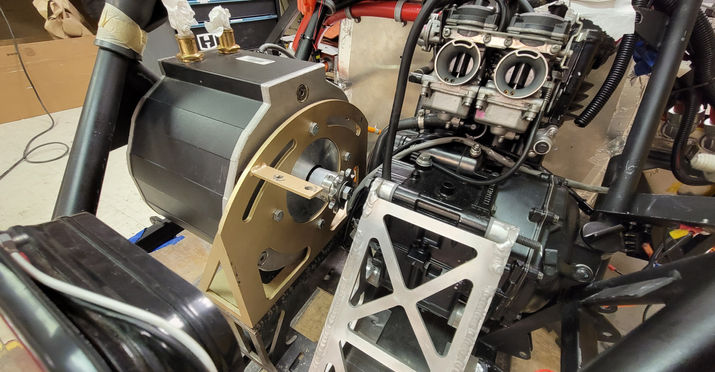
About Formula Hybrid+Electric
“The Formula Hybrid competition is an interdisciplinary design and engineering challenge for undergraduate and graduate university students. They must collaboratively design and build a formula-style hybrid or electric-only racecar and compete in a series of events. This educational competition emphasizes drivetrain innovation and fuel efficiency in a high-performance application.” - Formula Hybrid+Electric, https://www.formula-hybrid.org/

2025 WM4
While our previous competition vehicle served us well, the 2024/25 season called for a fresh start. Development of Let’er Buck began in the summer of 2024 and culminated in a victory in the FH+E Hybrid division, the first time Wyoming Motorsports not only completed a vehicle within a single year, but also competed and won.

We concentrated development on the suspension, chassis, packaging, aero, and ergonomics. Through rigorous pre-build validation and a deliberate emphasis on lightweight engineering as well as building on lessons from past designs, we achieved a tightly packaged vehicle with a dry weight of 598 lbs, a 23% reduction from its predecessor.

This vehicle ran a lightweight 98 V, 600 Wh centrally mounted accumulator, managed by an in-house developed PCB with integrated controls and safety systems. A parallel drive setup combines the MotoEnergy ME1616 and 2019 YZ250F, each driving a single limited-slip differential through separate chains.

For the first time, Wyoming Motorsports developed a full carbon-fiber aerodynamic package and bodywork, generating up to 110 lbs of downforce with only 40 lbs of drag at top speed. Designed through iterative CFD analysis, the system features large side-mounted nozzles and diffusers acting as efficient aerofoils to deliver meaningful downforce.












2024 WM3
For the 2023/24 season, our goal was to improve on the shortcomings of our competition-winning car by reducing weight, enhancing drivability, and increasing reliability. Key focus areas included the powertrain, ergonomics, and electrical systems. However, an electrical fault prevented us from completing inspection.

Key powertrain updates included a fully aluminum EV motor mount validated in FEA, a lightweight and power-dense 2019 YZ250F engine, an in-house developed electronic throttle body, improved packaging of auxiliary EV and ICE systems, and revised radiator placements. These changes reduced dry weight to 778 lbs, a ~15% reduction over the predecessor.

Other key updates included a lightweight pedal box validated via FEA, a custom 116 V, 1.6 kWh accumulator, and our first in-house PCB with integrated safety circuit controls. Additional improvements featured a 2:1 steering quickener, the first carbon fiber panels applied through bodywork, and a revised seating position achieved through seat modification.






2023 WM2
Building on lessons learned from our first competition in 2022, we significantly improved drivability, rules compliance, and reliability. These comprehensive updates across all systems enabled us to secure our first-ever first place in the Hybrid category.

Compared to the previous iteration, spring rates were updated and the chassis was stripped to install new tabs. Powertrain upgrades included a high-flow muffler, solid-linkage shifter and foot clutch for improved driver feel and reliability, revised radiators and fans, and strengthened axles to enhance durability.

The electrical system was extensively upgraded with a new wiring harness to eliminate faults and a custom dashboard for clear display of essential vehicle information. The vehicle retained its competitive 115 V, 4.3 kWh prismatic cell accumulators, mounted on either side of the driver, and paired the MotoEnergy ME1616 with the 2011 EX250J motor for outstanding performance.









2022 WM1
Wyoming Motorsports’ first competition entry, the WM1 in 2022, aimed to complete all technical inspections, a goal we achieved along with participating in the endurance event. The effort earned a second-place finish in the Hybrid category and provided valuable lessons for the following year.

Originally conceived in 2018 as a senior design suspension and chassis project, and later as an accumulator design in 2019, the project was revitalized in 2021 by a final senior design group who implemented the internal combustion engine, reinvigorating both the vehicle and the club.










.png)